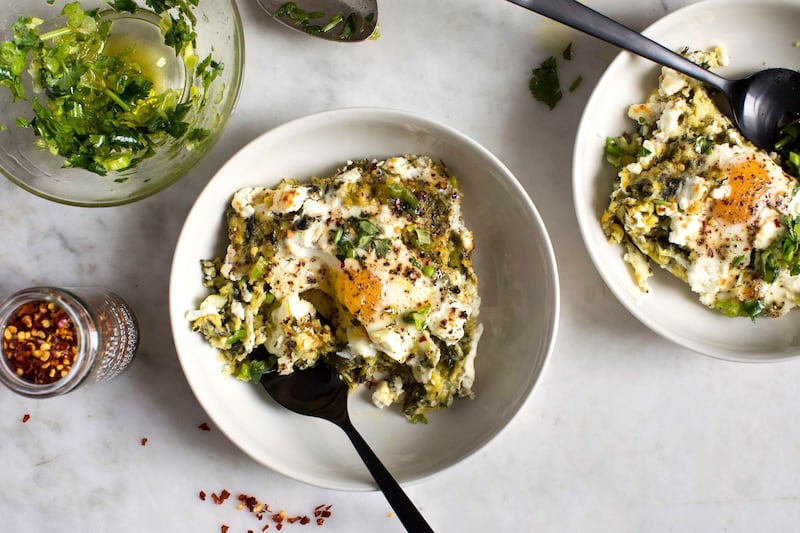I really like cooking dishes in the oven using just a single pot or pan. My inspiration was European classics, such as pasta with ragu, paella or moussaka, all of which come with long traditions attached to them and clear methods of preparation. None of these dishes, however, uses the single-pan-and-oven method.
Though it may look like an unnecessary and pretty precarious route to take, messing with tradition like that, I seem not to be able to stop myself. I have always had a mix of admiration and distrust for dishes that are “institutions”, knowing that they have withstood the test of time but also questioning the preciousness that seems to surround them. Claims of authenticity drive me up the walls.
So it is admiration that pushes me to have a go at the classics, and distrust that leads me to think that I can have a play.

Cooking polenta was a stoveside ritual in our house when I was growing up. My father, who is from an Italian family, would watchfully and continuously stir the pot with great patience
In the case of soft polenta, though, I was initially more reticent. Cooking polenta was a stoveside ritual in our house when I was growing up. My father, who is from an Italian family, didn’t cook it very often, but, when he did, he watchfully and continuously stirred the pot with great patience, making sure the polenta turned out perfectly smooth and creamy, and didn’t stick to the bottom of the pan. The polenta was then used as a base on which a simple sauce, made with minced beef, garlic, diced carrots and a tomato or two, was served.
For me the essence of the dish was this silkiness, punctuated by the textural sauce that sat on top without being stirred through. Every bite would include a bit of the smooth with a bit of the rough, the two never completely mixed up together.
This method, and the way it is served, had to be abandoned for my one-tray version; the "sauce" would mix with the polenta before the polenta even cooked. I have to give credit here to my test kitchen colleague Noor Murad, who had the foresight to turn polenta on its head by cooking it in the oven instead of on the stovetop. If it was up to me, I probably wouldn't have left the familiar safety of the pot and the wooden spoon.
The result is a rather bumpy type of polenta, full of textures and surprises, and nothing like the silky variety of my childhood. With runny eggs embedded in it, as well as lots of greens and chunks of cheese, it is wonderful in a very different way from my father’s polenta, rich and generous and gratifyingly complex.
It also offers another proof that rethinking and reinventing beloved dishes isn’t an act of betrayal. There’s always room for more than one version of a great thing.
HERBY POLENTA WITH CORN, EGGS AND FETA
Serves four to six
Cooking time: 75 minutes

Ingredients
255g frozen corn kernels, defrosted
200g baby spinach, roughly torn or sliced
150g coarse cornmeal
50g finely grated Parmesan
5 scallions, thinly sliced, 2tbsp reserved for garnish
20g roughly chopped fresh coriander, plus 1 tbsp finely chopped and reserved for garnish
3tbsp roughly chopped flat-leaf parsley
3tbsp roughly chopped fresh dill
4 garlic cloves, finely chopped
Salt and black pepper
530ml whole milk
475ml chicken stock
40g unsalted butter, cut into cubes
140g Greek feta, roughly crumbled
8 medium eggs, at room temperature
2tbsp olive oil
½tsp red-pepper flakes
Method
1 Heat the oven to 200 Celsius.
2 Add the corn to a food processor and pulse once or twice, just until roughly chopped. Transfer the corn to a large bowl and add the spinach, cornmeal, Parmesan, scallions, coriander, parsley, dill, garlic, 1½ teaspoons salt and a good grind of pepper; stir to combine. Transfer this mixture to a large, deep, ovenproof skillet, then add the milk, stock and butter, stirring gently to mix through. Transfer to the oven and bake for 20 minutes, then remove from the oven and give everything a good whisk.
3 Return to the oven and bake until the cornmeal is cooked through and the mixture has thickened (about 20 minutes). Give the polenta another good whisk — it should be quite smooth and not completely set — then stir in half the feta. Increase the oven temperature to 220 Celsius.
4 Use a dinner spoon to make eight shallow wells in the polenta. Crack an egg into each well and sprinkle lightly with salt and pepper. Sprinkle the remaining feta all over, and bake until the egg whites are cooked and the yolks are still runny (10 to 15 minutes).
5 Meanwhile, combine the reserved scallions and coriander in a bowl with the oil. Spoon this mixture all over the polenta and eggs and sprinkle with the red-pepper flakes. Serve directly from the pan. – New York Times











